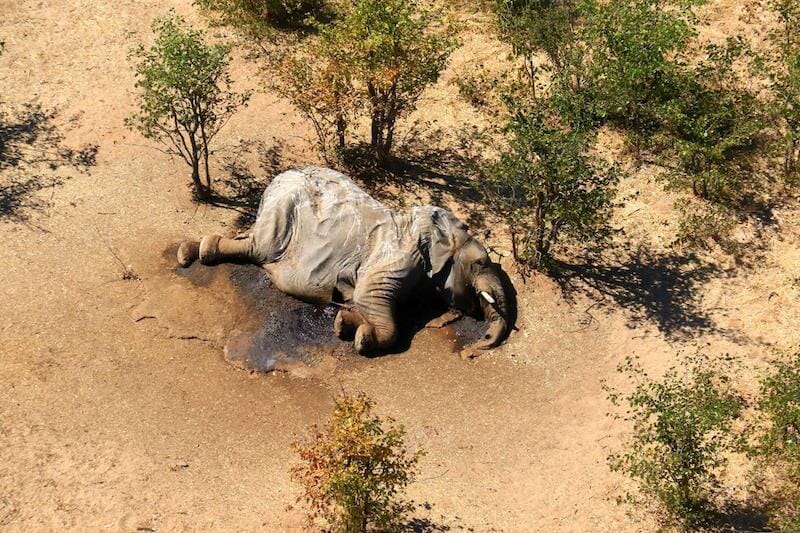One of the stories we’ve been following closely over the past few months has been the confounding mystery surrounding the mass die-off of dozens of elephants in Botswana. Eventually, the death toll rose to more than 300 of the creatures, which sent alarm bells off amongst conservationists.
While the sheer number of dead elephants was concerning, what worried them most was that the cause of those deaths was not readily apparent. This generated a lot of speculation amongst researchers and biologists, with theories ranging from a deadly new disease sweeping through the herds to poison in the local water supply.
Weeks of Exhaustive Testing
Now, after weeks of exhaustive testing and research, scientists believe they have found the answer at long last.
Last week, Cyril Taolo—the acting director of the Department of Wildlife and National Parks in Botswana, shared some vital information regarding the elephant die-off. According to Taolo, who received his information from researchers from a Botswanan lab, the animals likely died from ingesting toxic algae found in their watering holes.
He is quoted as saying that the deaths were due to “a toxic bloom of cyanobacterium in seasonal pans (water sources) in the region.” In this case, the region is the Seronga area, not far from the Okavango Delta.
Dry Season
Botswana is known for its long dry season, although heavy seasonal rains bring enough water to fill the pans for extended periods of time. Those watering holes then lure in all manner of creatures seeking moisture to help them survive in the dry, arid environment.
Without them, few animals could exist for very long in that part of the world, including elephants. The massive mammals drink more than 50 gallons (189 liters) of water every day, which means they may have been exposed to more toxic algae than other species.
That would explain why there were so many dead elephants, while other species’ carcasses haven’t been found in large numbers.

As further evidence supporting this theory, Taolo reports that the elephant die-off ceased as the watering holes dried up. The elephants may have wandered off with less water around to drink, leaving the toxic cyanobacterium behind.
Samples of the algae have been found in the dried-up watering holes, lending even more credence to the idea that it could be the cause of death. But because the elephant bodies have decomposed too much over the past few months, it is now impossible to check for traces of their system’s algae.
Toxic Cyanobacterium?
While finding the toxic cyanobacterium in the water is an important clue, researchers haven’t ruled out foul play by humans either. No traces of poison have been found, nor has the elephants’ death been consistent with that method, but it is considered the second-best alternative explanation.
Researchers haven’t been able to identify any types of known poison in their systems either, nor has anthrax been detected either. Poaching was also immediately ruled out, as the tusks for all of the creatures were still intact.
Aerial Survey
The first signs that something was wrong came in late June during an aerial survey of the Seronga region. Rangers and conservationists flew in small aircraft and helicopters so that they could spot animals on the ground.
Much to their dismay, in addition to seeing a thriving wildlife population, they also came across a large number of dead elephants. This quickly prompted an on the ground follow-up, which allowed scientists to retrieve samples from the quickly-decomposing bodies.
Those samples were then shared with laboratories in the U.S., U.K., Zimbabwe, and Botswana. Since then, we’ve been waiting for the results to arrive.

Toxic Algae to Blame
Right now, the Botswanan government has largely accepted the “toxic algae” explanation and is preparing to move on. While research will continue, no major revelations are expected to be uncovered.
Thankfully, the loss of the 350 elephants—while tragic—won’t have a major impact on Botswana’s elephant population. The country is home to the largest herds of wild elephants on the African continent, with more than 120,000 creatures believed to live there.
That is a staggering number, particularly since elephants are an endangered species in many other countries.
You can find out more about this story by clicking here.
- Gear Review: The Xero Scrambler Mid is an Ultralight Hiking Shoe for Spring - March 1, 2023
- Gear Review: Yeti Roadie 48 Wheeled Cooler - August 18, 2022
- Kristin Harila Continues Pursuit of 8000-Meter Speed Record - August 16, 2022
